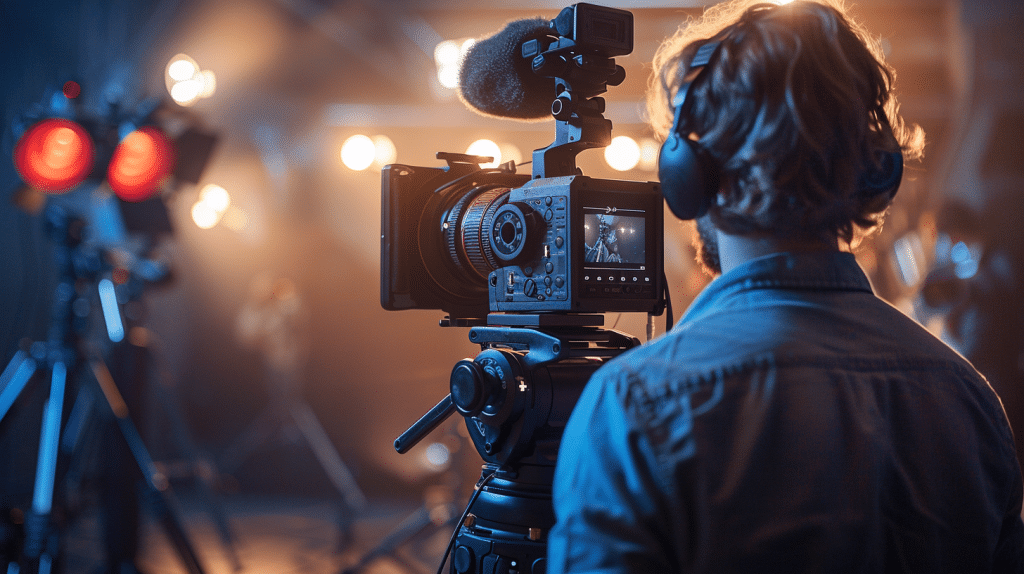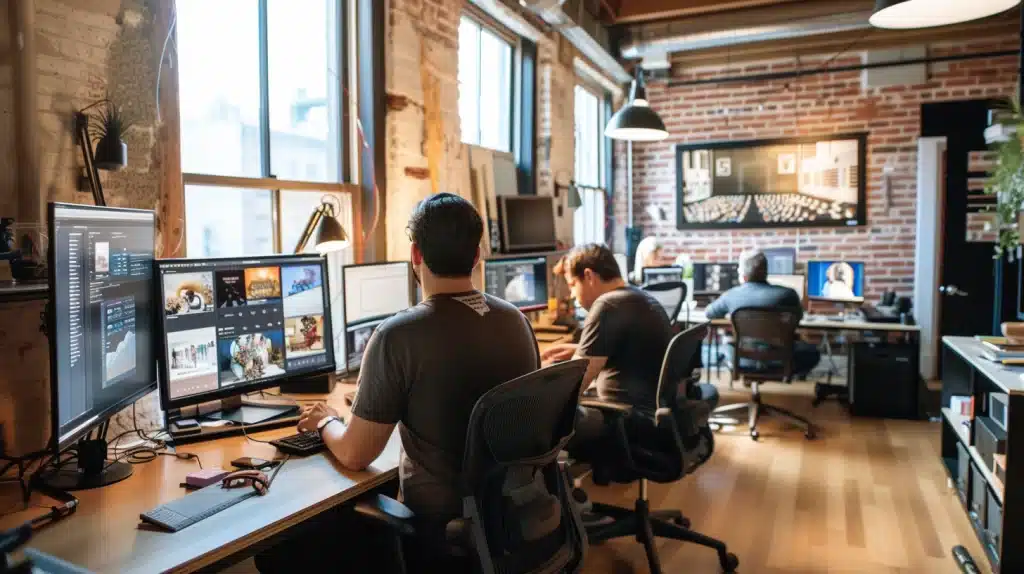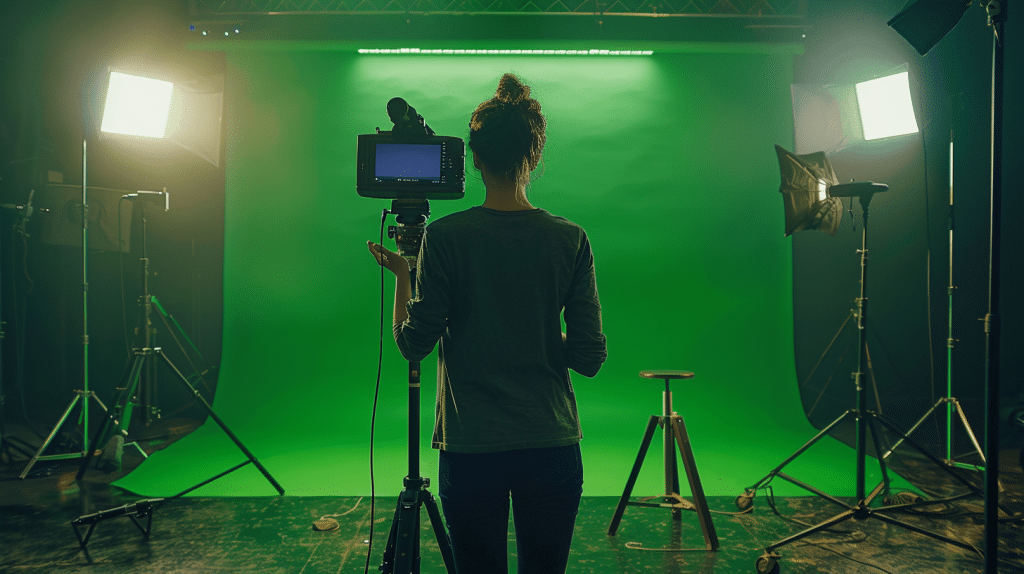Understanding Film Production Terms and Definitions: A Comprehensive Guide

You might think understanding film production terms and definitions is unnecessary if you’re not directly involved in filmmaking, but having this knowledge can greatly enhance your appreciation and critique of films.
This guide covers everything from pre-production essentials to distribution strategies, breaking down complex jargon into digestible explanations.
By familiarizing yourself with these terms, you’ll find it easier to discuss films with more insight and precision.
Whether you’re a budding filmmaker or an enthusiast looking to deepen your understanding, this inclusive guide offers the tools you need to effectively engage with the world of film production.
Ready to expand your cinematic vocabulary?
Table of Contents
Pre-Production Essentials

In the pre-production phase, you’ll meticulously plan every detail to guarantee a seamless filming process.
Start with a thorough Script Breakdown to identify every element—props, costumes, special effects, and more.
This step is vital as it informs budget allocation, scheduling, and resource management.
You’ll dissect the script scene-by-scene, listing all necessary components and assigning them to specific departments. It’s not just about recognizing what’s needed; it’s about understanding how each element impacts the overall production.
Next, immerse yourself in Location Scouting.
Find places that not only match your script’s requirements but also fit within logistical constraints. You’ll visit multiple sites, considering factors like lighting, sound, accessibility, and permits.
Don’t overlook the importance of securing backup locations in case of unforeseen issues. Your goal is to make sure that each setting enhances the narrative while remaining practical for the crew.
Both Script Breakdown and Location Scouting are foundational activities that set the tone for the entire project.
They require a keen eye for detail and a strategic mindset. Proper execution here will save time and money, allowing your production to run smoothly from day one.
Key Roles on Set

Every successful film set thrives on the coordinated efforts of key roles that bring the director’s vision to life.
The director, at the helm, collaborates closely with the producer to make sure that creative and logistical elements align seamlessly.
The assistant director (AD) is essential, managing the shooting schedule and maintaining set etiquette, ensuring that everyone knows their responsibilities and adheres to the timeline.
Cinematographers, or directors of photography (DP), translate the director’s vision into visual storytelling, deciding on camera angles, lenses, and lighting.
Production designers craft the visual environment, setting the tone and feel of each scene.
Set decorators, working under the production designer, dress the set with props and decor that enhance the story.
Sound mixers and boom operators capture crisp audio, an important component often overlooked.
Makeup artists and costume designers create the characters’ appearances, ensuring continuity and authenticity.
Grip and gaffer teams handle the physical and electrical aspects of lighting and rigging, working closely with the DP.
Lastly, the script supervisor maintains script continuity, ensuring that scenes flow logically and consistently.
Camera and Lighting Terms

When you’re on set, understanding camera and lighting terms is essential for achieving your creative vision.
You’ll want to master key camera angles, essential lighting techniques, and the basics of camera movement to make sure your shots are both dynamic and visually compelling.
Let’s break down these fundamentals to elevate your production value.
Key Camera Angles
Mastering key camera angles not only enhances the visual storytelling of your film but also strategically influences the audience’s emotional engagement and perspective.
An overhead shot, for example, can convey a sense of surveillance or detachment, offering the audience a bird’s-eye view that can make characters appear small and vulnerable. This angle is particularly effective in scenes requiring heightened tension or a god-like perspective.
Conversely, the low angle shot has its own unique impact.
By placing the camera below the subject, shooting upwards, you can imbue characters with an aura of power and dominance. This angle is often used to make protagonists or antagonists appear larger than life, thereby shifting the audience’s perception to see these characters as formidable forces.
Use these angles purposefully to manipulate the narrative tone. For instance, shifting from an overhead shot to a low angle can signify a dramatic change in power dynamics.
Keep in mind that each angle you choose must serve the story, enhancing the emotional texture and guiding the audience’s focus.
Integrating these angles thoughtfully into your film will help you craft a compelling visual journey.
Essential Lighting Techniques
Just as camera angles shape the narrative’s visual impact, strategic lighting techniques are pivotal in setting the film’s mood and atmosphere.
Mastering light placement and shadow techniques can greatly enhance your film’s visual storytelling.
Here are three essential lighting techniques every filmmaker should know:
- Three-Point Lighting: This classic technique involves using a key light, fill light, and backlight to create depth and dimension. Proper light placement helps to highlight the subject while controlling shadows.
- Chiaroscuro Lighting: Ideal for dramatic scenes, this technique uses high-contrast lighting to create stark shadows and intense highlights. It’s perfect for adding depth and a sense of mystery.
- Practical Lighting: Incorporating actual light sources from within the scene, like lamps or candles, helps to enhance realism. This method uses strategic light placement to integrate seamlessly with the set’s natural shadows.
Camera Movement Basics
Understanding camera movement is essential for crafting dynamic and engaging film scenes, as it directs the viewer’s attention and enhances cinematic storytelling.
As a filmmaker, you need to master various camera techniques to create visual interest and convey emotion effectively.
Tracking shots are a fundamental tool in your arsenal.
By moving the camera alongside your subject, you can maintain a consistent frame while adding a sense of motion and urgency. This technique is particularly effective in action sequences or when you want to immerse your audience in the character’s journey.
Dolly zooms, also known as the ‘Vertigo effect,’ offer a unique way to manipulate perspective.
By simultaneously zooming in with the lens while dollying the camera backward (or vice versa), you create a disorienting effect that draws attention to a specific moment or emotional state. This technique is perfect for heightening tension or illustrating a character’s psychological shift.
Each of these movements requires precise execution and strategic planning.
Understanding when and how to use tracking shots and dolly zooms can elevate your storytelling, making your film not just seen, but felt.
Always remember, the camera isn’t just a tool; it’s an extension of your narrative vision.
Sound and Audio Lingo

When you’re working on sound and audio, understanding Foley and ADR is essential for creating realistic and seamless audio tracks.
You can’t overlook the significance of sound mixing basics, which bring all your audio elements together in perfect harmony.
Mastering these concepts will elevate your film’s auditory experience and guarantee professional-quality results.
Foley and ADR
In the domain of sound design, Foley and ADR are essential techniques that bring depth and realism to a film’s audio landscape.
Foley techniques involve creating everyday sound effects that sync up perfectly with the actions on screen, adding layers of authenticity to the visuals. Think of footsteps crunching through snow or the rustling of a jacket—these sounds are meticulously crafted by Foley artists.
The ADR process, or Automated Dialogue Replacement, comes into play when dialogues recorded on set are unclear or need reworking.
Actors re-record their lines in a studio setting, ensuring crisp and clear audio that matches their on-screen lip movements. This technique is vital for maintaining the integrity of the film’s narrative.
Consider the following key points:
- Foley Artistry: Crafting sound effects like footsteps, weather sounds, and object interactions.
- ADR Sessions: Re-recording dialogues to fix audio issues or improve performance delivery.
- Seamless Integration: Both techniques require precise timing and skill to blend naturally with the on-set audio.
Mastering Foley and ADR can greatly enhance your film’s audio quality, making every scene more immersive and engaging.
They’re not just technical necessities but art forms that enhance storytelling through sound.
Sound Mixing Basics
Building on the intricacies of Foley and ADR, sound mixing basics are where you guarantee every audio element harmonizes perfectly to create a cohesive and immersive auditory experience.
You’ll often start with raw tracks, including dialogue, Foley, and ADR, as well as background sounds and musical scores. It’s your job to balance these elements using mixing consoles, ensuring nothing overshadows the pivotal moments.
First, focus on live sound.
Capturing high-quality live sound is essential; it forms the backbone of your audio track. When you’re on set, pay close attention to mic placement and ambient noise to avoid complications during post-production.
Next, move to the mixing consoles.
These sophisticated pieces of equipment allow you to adjust levels, EQ, and effects with precision. Whether you’re using an analog or digital console, understanding its layout and capabilities is critical.
You’ll balance dialogue clarity with the richness of your musical score, ensuring that every soundbite contributes to the storytelling.
Editing and Post-Production

Editing and post-production are critical phases where your raw footage transforms into a polished, cohesive narrative.
These stages involve meticulous attention to detail and strategic thinking to make sure your film reaches its full potential.
One of the first steps is color grading, which adjusts the colors and tones to achieve the desired mood and aesthetic. This step can drastically alter the visual impact of your scenes.
Incorporating visual effects (VFX) is another essential aspect. VFX allows you to add elements that weren’t captured during shooting, creating scenes that push the boundaries of reality.
It’s important to coordinate closely with your VFX team to ensure these additions seamlessly integrate with the live-action footage.
Here’s a snapshot of what you’d typically handle during post-production:
- Editing: Cutting and arranging footage to create a coherent storyline.
- Sound Design: Adding, enhancing, or manipulating audio elements.
- Titles and Credits: Designing and integrating text elements into the film.
Each of these elements requires a keen eye for detail and a thorough understanding of the film’s overall vision.
By mastering editing and post-production, you can elevate your project from a collection of raw scenes to a compelling cinematic experience.
Special Effects Vocabulary

When diving into the world of special effects, you’ll encounter a specialized vocabulary that’s essential for executing visually stunning and seamless scenes.
Understanding these terms will help you seamlessly blend practical effects and CGI integration to create compelling narratives.
Practical effects, often referred to as ‘practicals,’ are physical, real-world effects created on set.
These include explosions, prosthetic makeup, and animatronics. They’re invaluable for adding tangible realism to your scenes. For instance, using a physical model of a spaceship can provide a sense of authenticity that’s hard to replicate with digital tools alone.
On the other hand, Computer-Generated Imagery (CGI) integration involves digital effects created using computer software.
Terms like ‘rendering,’ which is the process of generating the final image from a model, and ‘compositing,’ which combines multiple visual elements into a single image, are essential here.
CGI allows for flexibility and creativity, enabling you to create anything from lifelike creatures to expansive, otherworldly landscapes.
Mastering the balance between practical effects and CGI integration is key. By strategically using both, you ensure scenes are both realistic and fantastical when necessary.
This vocabulary will equip you to make informed decisions and collaborate effectively with your special effects team.
Distribution and Marketing

Effective distribution and marketing strategies are essential for ensuring your film reaches its target audience and achieves commercial success.
You need to carefully select the right distribution channels and tailor your marketing strategies to maximize visibility and engagement.
Here’s a strategic approach to get you started:
- Identify your target audience: Understand who your film appeals to and where they spend their time. This could be specific age groups, interest communities, or geographic locations.
- Choose the right distribution channels: Leverage a mix of traditional and digital platforms, such as cinemas, streaming services, and social media. Each channel has its own strengths and can help you reach different segments of your audience.
- Craft compelling marketing materials: Create trailers, posters, and social media content that resonate with your audience and convey your film’s unique selling points.
Common Production Acronyms
Mastering common production acronyms not only streamlines communication on set but also enhances your efficiency and professionalism in the filmmaking process.
When discussing budget planning, you’ll often encounter EFC (Estimated Final Cost), which helps forecast total production expenses, and ATL/BTL (Above the Line/Below the Line), important for categorizing costs related to key creative roles versus technical crew and other expenditures.
In terms of your shooting schedule, the term DOP (Director of Photography) is pivotal, as this person oversees the visual aspect of your film.
Understanding AD (Assistant Director) roles is also essential; the 1st AD manages the set and keeps the shooting schedule on track, while the 2nd AD handles logistics like call sheets and cast movements.
Familiarize yourself with terms like MOS (Mit Out Sound), indicating a scene shot without recording audio, and OTS (Over the Shoulder), a common camera angle.
Knowing these acronyms ensures you can follow and contribute to conversations efficiently, making your production processes smoother and more cohesive.
By integrating these acronyms into your daily vernacular, you’ll not only save time but also demonstrate a deep understanding of the industry’s operational nuances.
Frequently Asked Questions
What Are the Different Types of Film Genres?
When you’re diving into genre analysis, you’ll find various film genres like action, comedy, drama, horror, sci-fi, and romance.
Each genre has its unique elements that cater to specific audience appeal.
For instance, action movies thrill with high stakes and fast pace, while romances charm with emotional connections.
Strategically, understanding these genres helps you target your audience more effectively and craft stories that resonate deeply.
How Do Film Festivals Impact a Movie’s Success?
Film festivals foster fantastic film success. They greatly shape a movie’s journey by enhancing audience reception and providing pivotal networking opportunities.
When your film premieres at a prominent festival, it garners critical attention and audience acclaim, which can drive its popularity.
Additionally, festivals are fertile grounds for forging relationships with industry professionals, distributors, and financiers, strategically positioning your film for broader distribution and commercial success.
What Is the Role of a Film Critic?
As a film critic, your role is pivotal. You provide critical analysis of a movie’s elements, like direction, acting, and screenplay. Your reviews help shape public perception and audience influence.
A well-written critique can elevate a film’s reputation or highlight its flaws. By offering insightful, strategic evaluations, you guide viewers’ decisions and contribute to a film’s overall success in the industry.
How Does Film Financing Work?
When you’re diving into film financing, you’ll need to master budget planning and investment strategies. First, you’ll create a detailed budget outlining all costs.
Next, you attract investors by presenting your film’s financial potential and strategic plan. You might secure funding through pre-sales, private equity, or tax incentives.
Always make sure your investment strategies align with your film’s goals to maximize returns and minimize risks.
What Is the Importance of a Film’s Screenplay?
Think of a film’s screenplay as its beating heart. It drives character development and shapes the dialogue structure, ensuring the story comes alive.
Without a strong screenplay, your film risks falling flat, losing the essence that captivates audiences.
A well-crafted script meticulously defines characters, outlines their arcs, and strategically builds dialogue, creating a cohesive narrative that’s essential for a successful production.
Don’t underestimate its importance!
It’s A Wrap!
You’re now equipped with the tools to navigate the labyrinth of film production.
By mastering these terms, you’ll be able to hit the ground running and communicate like a pro.
Remember, the devil’s in the details; understanding each aspect can make or break your project. So keep this guide handy, and you’ll be one step ahead, ensuring your cinematic vision comes to life seamlessly and successfully.
Happy filming!
Share:
Search our blog:
Follow us on:
